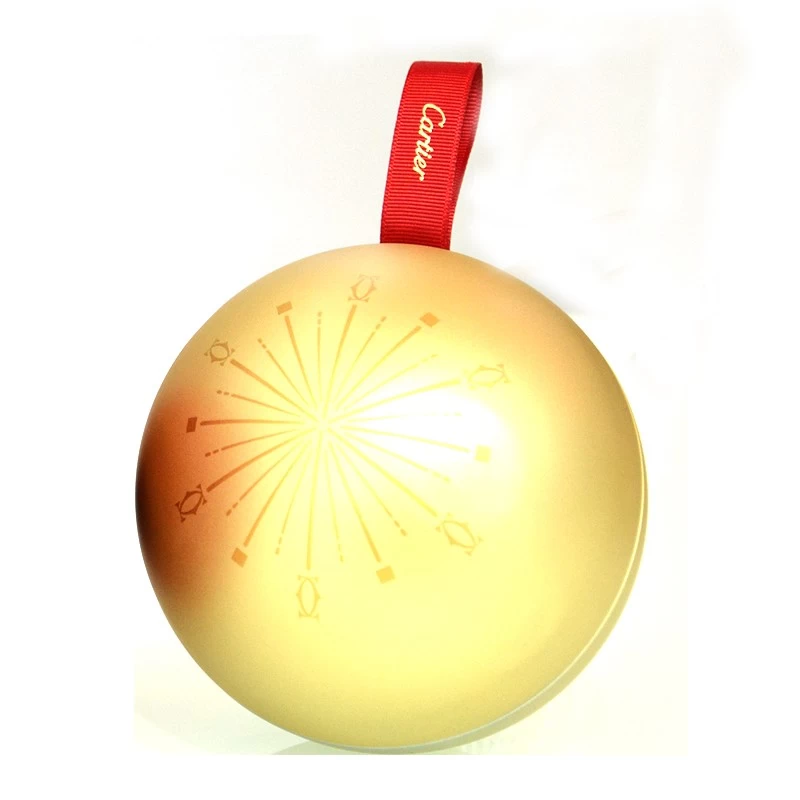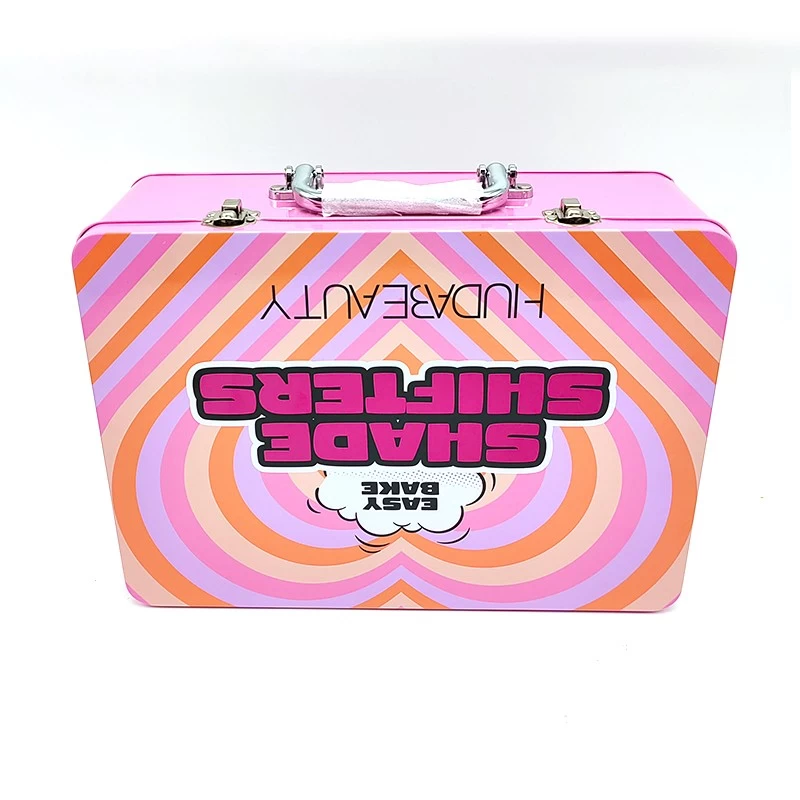This year we carefully created a PU leather handle coffee tin box for the coffee brand. The size is 185x136x85mm. It is made of food-grade tinplate and the material thickness is 0.23mm.
This year, Cosmetics Brands joined hands with our professional tin box manufacturer to create a cosmetic tin box with handle that combines beauty and practicality. This is not only a container for beautiful things, but also an ode to a refined attitude towards life.
The Xmas detachable candy balls is made of tinplate, the iron box is strong and durable. It is not easy to open directly, you can easily open the hemisphere without the string by pulling the string. The Christmas ball can be used as a candy jar, and the candy ball has enough space for candies, chocolates, trinkets, and small things. At the same time, its lovely shape and hanging ribbon are also perfect for Christmas tree decoration
Material and safety Food-grade tinplate material, light and durable, drop-proof and rust-proof, in line with food safety standards. The interior adopts environmentally friendly coating, no odor, and can directly contact food. Customized printing Full-surface high-definition printing: supports single-sided/double-sided customization of corporate logos, patterns, slogans or art designs. Process selection: silk screen printing, hot stamping, UV embossing and other processes are optional to enhance the brand texture. Applicable scenarios: employee benefits, event gifts, promotional gifts, campus customization, etc.
Our round tin cookie box is an elegant and practical packaging solution designed to keep your cookies fresh and beautifully presented. Made from high-quality tinplate, it offers excellent durability and protection against moisture and breakage. The smooth, classic round shape adds a touch of sophistication, making it perfect for gifts, festive treats, or everyday storage. With customizable designs, sizes, and finishes, this tin box not only preserves the delicious taste of your cookies but also enhances your brand’s image with eye-catching, reusable packaging.
This heart-shaped tin box is made from food-grade material, making it safe for storing a variety of candies and gifts. Perfect for the holiday season, this charming tin adds both function and holiday cheer to any celebration.
These discreet low profile rectangle tins feature a clean & fresh style that will remain modern for many uses to come. Our lightweight durable containers are made from high-quality material. Reliable hinge & seal for a perfect closure every time. General household organizing, crafts, homemade packaging, store spices, tea leaves, coffee beans, chocolates, mints, creams, balms, gels, jewelry, beads, sequins, recipe cards, arts, medicines, pills, lip balm, cosmetics, gifts, party favors, Double button locking hinged lid that offers great child resistant packaging.
Designed for exquisite chocolates, our custom food-grade rectangular chocolate tinplate boxes provide safe, beautiful and highly flexible packaging solutions. This packaging box is strictly made of high-quality tinplate materials that meet food contact safety standards (such as FDA/GB) to ensure that the contents are pure and uncontaminated. The classic rectangular design is not only simple and elegant in appearance and full of modernity, but also can efficiently utilize space, making it easy to stack, transport and retail display. The core advantage lies in its deep customization service - you can freely choose the box size, color (internal and external coating), pattern printing (high-definition color printing, hot stamping/silver, etc.), and lining material (such as food-grade white cardboard tray, PET blister tray, flannel, etc.), perfectly carrying and enhancing the value and protection of your brand chocolate. The sturdy iron box structure provides excellent sealing and moisture-proof performance, effectively extending the freshness and shelf life of chocolate, and is an ideal packaging choice for high-end chocolate brands, gift markets and baking industries.
In the packaging industry, tin boxes and paper boxes are two common packaging forms, each of which meets the needs of different products with its unique materials and processes. Whether it is high-end gifts, canned food, or daily consumer goods, packaging is not only a "coat" to protect the product, but also a direct reflection of the brand image. However, there are significant differences between tin box printing and paper box printing in terms of materials, processes, effects, etc. These differences directly affect the cost, appearance and functionality of the packaging. So, what are the specific differences between tin box printing and paper box printing? How to choose the right packaging method according to the characteristics of the product? This article by Shangzhimei food grade tin container manufacturer will analyze the differences between the two in detail for you to help you better understand and make a wise choice.

1. Material properties
Iron box printing:
Material: Usually use metal materials such as tinplate (tinplate), aluminum, etc.
Features: Smooth, hard surface, pressure-resistant, corrosion-resistant, suitable for long-term storage of contents.
Pretreatment: The iron sheet needs to be cleaned, primed, etc. before printing to enhance ink adhesion and rust resistance.
Paper box printing:
Material: Use paper or cardboard, such as white cardboard, gray cardboard, corrugated paper, etc.
Features: Rough surface, soft, easy to fold, but poor pressure resistance and waterproofness.
Pretreatment: Paper usually only needs calendering or lamination to improve surface smoothness and waterproofness.
2. Printing process
Iron box printing:
Printing method: mainly lithographic offset printing or screen printing.
Process characteristics:
After printing, it needs to be baked at high temperature (usually 150℃-200℃) to solidify the ink and ensure adhesion.
The printed pattern needs to consider the ductility of the metal material to avoid deformation during subsequent stamping.
The ink thickness needs to be strictly controlled during the printing process to prevent color difference or falling off after baking.
Printing equipment: Special metal printing machine, the equipment cost is relatively high.
Carton printing:
Printing method: Common offset printing, gravure printing, flexographic printing or digital printing.
Process characteristics:
The ink is dried naturally, cured by ultraviolet (UV) or dried by infrared.
The printed pattern can be presented directly on the paper without considering the ductility of the material.
Fast printing speed, suitable for mass production.
Printing equipment: Ordinary paper printing machine, the equipment cost is relatively low.
3. Ink type
Iron box printing:
Use special metal ink, which must have the following characteristics:
High temperature resistance: no discoloration or falling off during baking.
Strong adhesion: can be firmly attached to the metal surface.
Corrosion resistance: suitable for packaging of food, cosmetics, etc., to avoid reaction with the contents.
Common ink types: epoxy resin ink, polyester ink, etc.
Carton printing:
Use ordinary ink or environmentally friendly ink, such as water-based ink, UV ink.
Ink characteristics:
Fast drying speed, no high temperature baking required.
The color expression is strong, but the durability is not as good as metal ink.
It is environmentally friendly and suitable for packaging with high safety requirements such as food and medicine.

4. Printing effect
Iron box printing:
Bright colors, high gloss, and clear patterns.
The reflective effect of the metal surface can enhance the visual impact and is suitable for high-end packaging.
The printed pattern is durable and not easy to fade or wear.
Paper box printing:
The color expression is good, but the gloss and three-dimensional sense are not as good as iron box printing.
The printing effect is greatly affected by the texture of the paper. For example, rough paper may cause the color to be not bright enough.
The pattern has poor durability and is easily affected by humidity, friction and other environmental factors.
5. Post-processing technology
Iron box printing:
Stamping: The printed iron sheet needs to be stamped into a specific shape through a mold.
Welding or seam treatment: The edge of the iron box is welded or seamed to ensure sealing.
Surface treatment: Hot stamping, embossing, lamination and other processes can be performed to improve the appearance texture.
Cost: The post-processing process is complicated, the equipment investment is large, and the production cost is high.
Paper box printing:
Die cutting and creasing: The paper is cut into the desired shape by a die cutting machine, and the creases are pressed out.
Pasting box: The die-cut cardboard is folded and glued into a box.
Surface treatment: Lamination, hot stamping, UV local glazing and other processes can be performed to improve the appearance.
Cost: The post-processing process is simple, the equipment investment is small, and the production cost is low.
6. Application areas
Iron box printing:
High-end gift boxes: such as tea boxes, chocolate boxes, moon cake boxes, etc.
Food cans: such as cans, biscuit boxes, etc.
Cosmetic boxes: such as perfume boxes, skin care boxes, etc.
Industrial packaging: such as paint cans, chemical cans, etc.
Paper box printing:
Food packaging: such as snack boxes, beverage boxes, etc.
Pharmaceutical packaging: such as medicine boxes, health care product boxes, etc.
Electronic product packaging: such as mobile phone boxes, earphone boxes, etc.
Daily consumer goods packaging: such as toy boxes, pencil cases, etc.
7. Environmental protection
Iron box printing:
Advantages: Metal materials can be recycled and are environmentally friendly.
Disadvantages: High energy consumption in the production process, and the ink may contain heavy metal components.
Paper box printing:
Advantages: Paper is degradable, low energy consumption in the production process, and environmentally friendly.
Disadvantages: Poor durability, easily affected by the environment, and may require lamination (not easy to degrade after lamination).
8. Cost comparison
Iron box printing:
Material cost: high.
Printing cost: high (special equipment, ink and complex process).
Post-processing cost: high (complex processes such as stamping and welding).
Paper box printing:
Material cost: low.
Printing cost: low (universal equipment and simple process).
Post-processing cost: low (simple processes such as die-cutting and gluing).
Summary
There are significant differences in materials, processes, inks, effects, post-processing, applications and costs between printed tin boxes and paper boxes produced by metal box suppliers. Iron box printing is suitable for high-end and durable packaging, while paper box printing is more suitable for low-cost and large-volume packaging. The choice should be based on product characteristics, budget and target market.